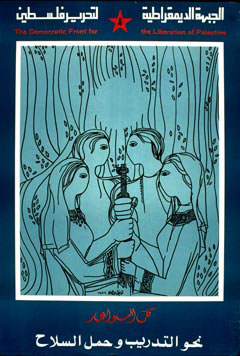All Arms
Artist: Tawfiq Abdel Al (Palestine)
Dimensions: Approximately 19” x 28”
Publisher: The Democratic Front for the Liberation of Palestine (DFLP)
1976
This poster depicts four Palestinians, two women wearing traditionally embroidered dresses along with two men, taking an oath of revolutionary commitment in a grove of trees. All four have grasped a rifle, the symbol of armed struggle. The rifle is pointed upwards toward the sun, represented by a line-free circle amidst the trees.
The Democratic Front for the Liberation of Palestine (DFLP) is one of numerous factions, along with the Popular Front for the Liberation of Palestine (PFLP) and the Palestine National Liberation Movement (Al Fatah) that make up the Palestine Liberation Organization (PLO). Central to its particular ideological perspective is the belief in armed struggle to achieve the goal of national liberation.
Abdel Al, like many Palestinian artists whose paintings are translated into posters, was classically educated in modern visual and design theory. His works reflect a unique nationalist style shaped, at least in terms of content, by years of conflict. Palestinian factions, or jebha (Arabic: front), often employ the works of artists who either are members or whose political and ideological leanings dovetail with that of the faction.

The Arabic script in white along the bottom of the poster reads: “Train together and take up arms” and is a recruitment call to join the DFLP.
Questions for A New Democratic Discussion
1) How does this poster compare, in terms of its recruitment message and psychology, with the inspirational posters of the early nation-building cadres in pre-independence Israel, such as Hashomer Hatza’ir, (Hebrew: Zionist Socialist Youth Movement)?
2) During World Wars I and II, the U.S. mobilized millions of citizens in civic and military activities. In doing so it used posters with strikingly similar compositions, messages, undertones and psychologies to this one. How is this poster different from those produced in the U.S. during its times of military mobilization?
3) Since this poster was published in 1976, how has the meaning of “armed struggle” evolved for the Palestinians? For the Israelis? What conditions have fostered those evolutions?
© 2003 Liberation Graphics. All Rights Reserved.Please send us your questions and comments (English only please!)
www.liberationgraphics.com